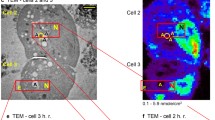Abstract
Quantitative synchrotron X-ray fluorescence (SXRF) imaging of adherent mouse fibroblast cells deficient in antioxidant-1 (Atox1), a metallochaperone protein responsible for delivering Cu to cuproenzymes in the trans-Golgi network, revealed striking differences in the subcellular Cu distribution compared with wild-type cells. Whereas the latter showed a pronounced perinuclear localization of Cu, the Atox1-deficient cells displayed a mostly unstructured and diffuse distribution throughout the entire cell body. Comparison of the SXRF elemental maps for Zn and Fe of the same samples showed no marked differences between the two cell lines. The data underscore the importance of Atox1, not only as a metallochaperone for delivering Cu to cuproenzymes, but also as a key player in maintaining the proper distribution and organization of Cu at the cellular level.



Similar content being viewed by others
Abbreviations
- Atox1:
-
Antioxidant-1
- BCS:
-
Bathocuproine disulfonate
- PBS:
-
Phosphate-buffered saline
- SXRF:
-
Synchrotron X-ray fluorescence
- TGN:
-
trans-Golgi network
- XRF:
-
X-ray fluorescence
References
Massaro EJ (ed) (2002) Handbook of copper pharmacology and toxicology. Humana Press, Totowa
Stohs SJ, Bagchi D (1995) Free Radic Biol Med 18:321–336
Valko M, Morris H, Cronin MTD (2005) Curr Med Chem 12:1161–1208
Harris ED (2000) Ann Rev Nutr 20:291–310
Puig S, Thiele DJ (2002) Curr Opin Chem Biol 6:171–180
Kim B-E, Nevitt T, Thiele DJ (2008) Nat Chem Biol 4:176–185
Bertinato J, L’Abbé MR (2004) J Nutr Biochem 15:316–322
Lalioti V, Muruais G, Tsuchiya Y, Pulido D, Sandoval IV (2009) Front Biosci 14:4878–4903
Turski ML, Thiele DJ (2009) J Biol Chem 284:717–721
Andrews NC (2002) Curr Opin Chem Biol 6:181–186
de Bie P, Muller P, Wijmenga C, Klomp LWJ (2007) J Med Genet 44:673–688
Loudianos G, Gitlin JD (2000) Semin Liver Dis 20:353–364
Gitlin JD (2003) Gastroenterology 125:1868–1877
Kitzberger R, Madl C, Ferenci P (2005) Metab Brain Dis 20:295–302
Bush AI (2003) Trends Neurosci 26:207–214
Bush AI (2000) Curr Opin Chem Biol 4:184–191
Gaggelli E, Kozlowski H, Valensin D, Valensin G (2006) Chem Rev 106:1995–2044
Barnham KJ, Bush AI (2008) Curr Opin Chem Biol 12:222–228
Macreadie IG (2008) Eur Biophys J Biophys Lett 37:295–300
Carrí MT, Ferri A, Cozzolino M, Calabrese L, Rotilio G (2003) Brain Res Bull 61:365–374
Wijesekera LC, Leigh PN (2009) Orphanet J Rare Dis 4:3
Rae TD, Schmidt PJ, Pufahl RA, Culotta VC, O’Halloran TV (1999) Science 284:805–808
Finney LA, O’Halloran TV (2003) Science 300:931–936
Waldron KJ, Rutherford JC, Ford D, Robinson NJ (2009) Nature 460:823–830
Elam JS, Thomas ST, Holloway SP, Taylor AB, Hart PJ (2002) Adv Protein Chem 60:151–219
Rosenzweig AC (2001) Acc Chem Res 34:119–128
Huffman DL, O’Halloran TV (2001) Annu Rev Biochem 70:677–701
O’Halloran TV, Culotta VC (2000) J Biol Chem 275:25057–25060
Luk E, Jensen LT, Culotta VC (2003) J Biol Inorg Chem 8:803–809
Culotta VC, Yang M, O’Halloran TV (2006) Biochim Biophys Acta Mol Cell Res 1763:747–758
Rothstein JD, Becker M, Hoberg MD, Culotta V, Corson L, Cleveland D, Price D, Wong P (1998) Ann Neurol 44:7
Abajian C, Yatsunyk LA, Ramirez BE, Rosenzweig AC (2004) J Biol Chem 279:53584–53592
Glerum DM, Shtanko A, Tzagoloff A (1996) J Biol Chem 271:14504–14509
Pierrel F, Cobine PA, Winge DR (2007) Biometals 20:675–682
Horng Y-C, Cobine PA, Maxfield AB, Carr HS, Winge DR (2004) J Biol Chem 279:35334–35340
Hamza I, Prohaska J, Gitlin JD (2003) Proc Natl Acad Sci USA 100:1215–1220
Hamza I, Faisst A, Prohaska J, Chen J, Gruss P, Gitlin JD (2001) Proc Natl Acad Sci USA 98:6848–6852
Pufahl RA, Singer CP, Peariso KL, Lin SJ, Schmidt PJ, Fahrni CJ, Culotta VC, Penner-Hahn JE, O’Halloran TV (1997) Science 278:853–856
Petris MJ, Mercer JFB, Culvenor JG, Lockhart P, Gleeson PA, Camakaris J (1996) EMBO J 15:6084–6095
Herd SM, Camakaris J, Christofferson R, Wookey P, Danks DM (1987) Biochem J 247:341–347
Lin SJ, Culotta VC (1995) Proc Natl Acad Sci USA 92:3784–3788
Itoh S, Kim HW, Nakagawa O, Ozumi K, Lessner SM, Aoki H, Akram K, McKinney RD, Ushio-Fukai M, Fukai T (2008) J Biol Chem 283:9157–9167
McRae R, Bagchi P, Sumalekshmy S, Fahrni CJ (2009) Chem Rev 109:4780–4827
Fahrni CJ (2007) Curr Opin Chem Biol 11:121–127
Lobinski R, Moulin C, Ortega R (2006) Biochimie 88:1591–1604
Ortega R, Devès G, Carmona A (2009) J R Soc Interface 6:S649–S658
Paunesku T, Vogt S, Maser J, Lai B, Woloschak G (2006) J Cell Biochem 99:1489–1502
Yang L, McRae R, Henary MM, Patel R, Lai B, Vogt S, Fahrni CJ (2005) Proc Natl Acad Sci USA 102:11179–11184
Finney L, Mandava S, Ursos L, Zhang W, Rodi D, Vogt S, Legnini D, Maser J, Ikpatt F, Olopade OI, Glesne D (2007) Proc Natl Acad Sci USA 104:2247–2252
Carmona A, Cloetens P, Devès G, Bohic S, Ortega R (2008) J Anal At Spectrom 23:1083–1088
McRae R, Lai B, Vogt S, Fahrni CJ (2006) J Struct Biol 155:22–29
Vogt S (2003) J Phys IV 104:635–638
Miyayama T, Suzuki KT, Ogra Y (2009) Toxicol Appl Pharmacol 237:205–213
La Fontaine S, Mercer JFB (2007) Arch Biochem Biophys 463:149–167
Acknowledgments
We thank Jonathan Gitlin (Washington University, St. Louis, USA) for providing us with samples of the Atox1−/− and Atox1+/+ cell lines. We also thank Stefan Vogt (Argonne National Laboratory) for providing support with the MAPS software package. Financial support from the National Institutes of Health (R01GM067169) is gratefully acknowledged. Use of the Advanced Photon Source was supported by the US Department of Energy, Office of Science, Office of Basic Energy Sciences, under contract no. DE-AC02-06CH11357.
Author information
Authors and Affiliations
Corresponding author
Additional information
This article will be printed in the upcoming Journal of Biological Inorganic Chemistry special issue Cell Biology of Copper.
Rights and permissions
About this article
Cite this article
McRae, R., Lai, B. & Fahrni, C.J. Copper redistribution in Atox1-deficient mouse fibroblast cells. J Biol Inorg Chem 15, 99–105 (2010). https://doi.org/10.1007/s00775-009-0598-1
Received:
Accepted:
Published:
Issue Date:
DOI: https://doi.org/10.1007/s00775-009-0598-1




